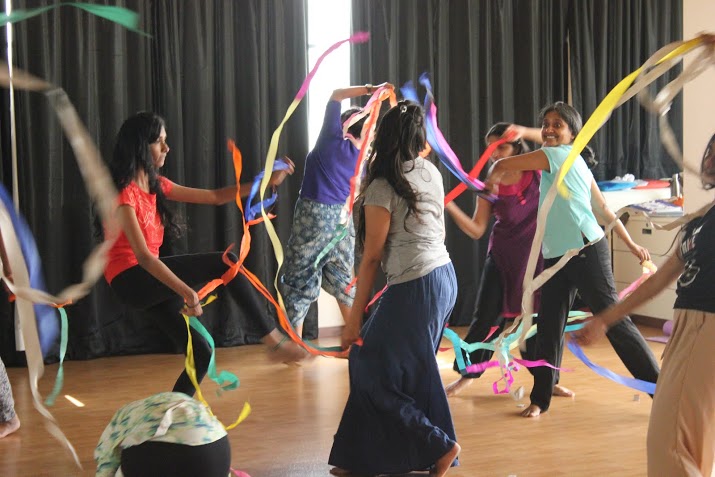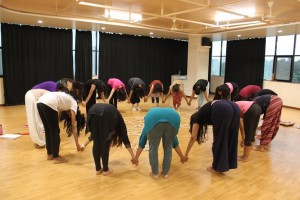
This is a good enough place to begin. From inside your own skin.
Before we could speak, we moved. We reached out to the world, we curled our fingers around safety, we grasped at colour, we turned away from fear and closed our eyes in the dark. We danced in excitement, ran towards horizons, and spun through raindrops. We grew taller, and hunched over in anxiety, flirted with pleasure and unlocked our palms and thighs to embrace more of the world around us.
Before words trained our tongues to move, we said everything we needed to through our bodies. Our bodies murmur things, but we’re too used to only listening for words.
Words are decided, predictable, more controlled. Movement is raw. Movement is honesty. When dance becomes a listening surrender to the rhythms of your own mind and body, then movement is truth. And to stumble on the truth, in a world designed to look the other way, is the smallest but most life- altering miracle one can hope for.
My first Dance Movement Therapy (DMT) workshop with Sohini Chakroborty of Kolkata Sanved was the place where I began to understand that movement in itself was a mysterious and fascinating language. As a first year counselling student and a lover of dance, I’d showed up not knowing what to expect from three days of dance movement therapy. I vaguely assumed that it would be a bunch of fun movement exercises we could use as buffers between more ‘serious’ (i.e verbal) therapy sessions. But there was so much more. As a writer, I was left reeling, and wordless – once I allowed myself to enter my own physical landscape, and move through it. Those three days helped me realize how disconnected the body is from the mind, and how traditional talk therapies often neglect the relationship between mind and body. Returning to work with somatic awareness can be a deeply powerful experience, because we begin to express emotions without the intrusion of words. Sometimes we can say through our movements what we cannot say with our voices.
So how do we begin these conversations?
Tripura Kashyap’s – one of India’s first trained dance movement therapists and founder of the Creative Movement Therapy Association of India – answer to this question involves building movement vocabulary, expression, catharsis and integration. The journey through these processes itself is a radical one to embark on – because it includes not just the mind, but the body, not just words but also gestures – and it embraces the unpredictable and instinctive, while also exploring what is instinctive and what is inherited.
As women, we’re trained to move through the world in certain ways. ‘Feminine’ ways – unassuming, diffident, and definitely not attention seeking. Our culture requires our movements to be hushed, modest, and discreet, and our expressions to match. Arms, legs, and ankles, folded into each other. Your chest, pulled inwards, a little bit. In a woman, confidence, exuberance and sensuality are distracting, and invite unapologetic attention, suspicion and aggression.
Dance movement therapists engage with the unlearning of this (and many other forms of) deep-rooted physical conditioning, by encouraging clients to explore different forms, rhythms, ways and movement. Going beyond masculine and feminine ways of inhabiting your body, therapists encourage clients to move as they feel like moving, to come from not conditioning, but emotion. A woman can spread her legs wide, a man can twirl delicately – and it does not matter if your movements ‘match’ your gender. The focus is not on looking beautiful or graceful – and there is no ‘correction’ of steps by the therapist, but an attentive acceptance of the ways one moves, and an expansive exploration of the multitudes of movements and rhythms possible. This builds a repertoire of movement vocabulary that goes beyond what our bodies are used to. Expression emerges from the exploration of the same. Sessions are often divided between sequences of free movement, or improvisations and pockets of reflection on the same movements, and the memories evoked. ‘This is how I felt when we did that exercise where we pretended to walk on broken glass. This is what I remembered when we used our wrists to dance.’
Our bodies are the places we have lived in all our lives. Every single memory we possess has had a physical ripple effect. The time your knees shook when your teacher yelled at you. The uneasy feeling that stayed in your stomach all summer, before your entrance results came out. The violent stab of anger felt when someone touches us against our will. There are sensations we have experienced, which we are sometimes hard-pressed to verbalise. By working with the body, we enter the nameless territory of sensation, and instead of words, we work with felt sensations that emerge during exercises. For example, survivors of sexual trauma often develop PTSD symptoms of disassociation, and do not feel ‘grounded’ within their own bodies. Having experienced such a deep violation of their body and physical helplessness, they often begin to feel numbness, shame, or rage towards their selves and bodies. DMT sessions encourage the body to communicate these emotions through gestures, movements, expressions. If survivors feel the need to verbalise and share further, they are listened to and validated. On a non-verbal level, there is catharsis and well as the reclaiming of the body by the self, and a felt experience of its fragility as well as its power. The most healing aspect of DMT for trauma survivors is the sense of physical autonomy and power that it cultivates. You are in charge of your own body, and only you decide how you wish to move. DMT sessions create lived, felt experiences where survivors can express pain, but also power, aggression, rage, and strength. Survivors in a group can witness others’ experiences and struggle with the same emotions which is a powerful way to validate their own experiences.
By consistently inhabiting a space where you are in charge of your body – experiencing its weakness, as well as its wildness, its tiredness as well as its turmoil and energy- one begins to grow familiar with its rhythms and closer to one’s self. Resolution occurs here on a psychosomatic level. Therapists observe the movement language of the client, understanding and exploring repetitive patterns of movement, their meanings and underlying emotions. By validating and exploring the metaphors that arise through the movements, integration between the mind and body emerges. Often, clients who have had difficulty verbalising certain emotions, begin to feel less threatened by them once they have articulated them physically – and begin to speak more deeply about them, and experience them differently. Their daily lives and interactions often alter. Kolkata Sanved’s work with a group of human trafficking survivors documented this reality. Clients who had experienced DMT over a 6-month period began to report greater comfort making eye contact, being assertive and feeling good about themselves and their bodies.
The term ‘dance’ movement therapy in itself is debated frequently between therapists who work with movement. The way most people see ‘dance’ is as something that is learned, practised, and used to seduce, entertain, or celebrate. Yet within the therapeutic space, we work with the creative rawness of movement, and the sole purpose is to express. There is no standard of physical perfection to strive for, but deeper emotional honesty. Tripura Kashyap has named her institute the Creative Movement Therapy Association of India, reinforcing the separation between traditional, populist notions of dance and the therapeutic realities of movement therapy.
The connections between art and DMT are being deepened, but if, at its core, art is an expression of what it means to be alive in the world (keeping debates on the subjectivity of aesthetics aside), then it includes the possibility of everybody cultivating art. Dance Movement Therapy is not focused on performance, but the cultivation of a space within you, from which expression emerges naturally, allowing the body to inhabit and move through its own metaphors, without aesthetic censoring. By giving physical permission for each human body to move without the pressure to look beautiful, or masculine, or socially appropriate, we make a small but powerful offering of freedom. We find a footing in a place that only requires us to be who we are, and express what moves through us. And this is art at its most alive and empathetic because it invites us to be free and to express ourselves and our stories without inhibition. One day the girl who always crosses her legs begins to stop. The week after that she dances, stamping her feet, and her gaze begins to raise itself from the floor.
If activism is about campaigning for the changing of a political or social order, then moving freely can be a way to explore and alter the embodied constructs of that order. Maybe a month from now, that girl will walk down a road and find someone staring at her. And for the first time in her life, she will not flinch, and she will stare back. Maybe his gaze will fall to the ground, or maybe it will continue to scrape her face. It doesn’t matter. She will have become the girl who won’t look away, because she finally feels strong enough not to. I believe that counts, because I have been where she has been. And in striving to move, speak and live more freely we are artists and activists, both.
(Special acknowledgments to Tripura Kashyap whose training and insights into DMT formed the backbone of this article, to Anubha Doshi, founder of Artsphere, Pune, for creating a space for a DMT community to emerge, and to Varun Vishwesh for photography.)
Pic Source: By Varun Vishwesh during the DMT workshop at Artsphere, Pune. Copyright belongs to Artsphere.

